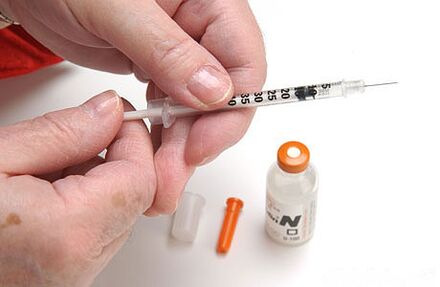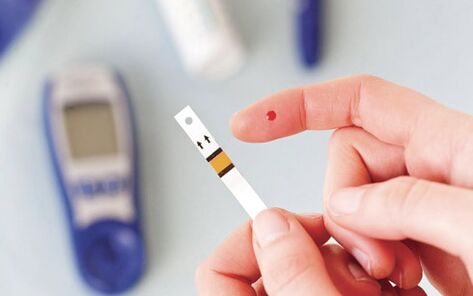Insulin - The hormonal secret of the processor plays an important role, ensuring the permanence of blood glucose. Diabetes mellitus is the result of this hormone. Complications caused by the disease often lead to death. The basic principles of the treatment of diabetes are strict adherence to the diet, taking medications or insulin injections, monitoring the glucose levels of the blood, and observation of the body not to miss the first signs of complications.
The pathogenesis of the disease
Diabetes mellitus is a lasting violation of the synthesis of insulin hormone and the interaction of the body tissues.
Insulin processes the resulting sugar into glucose and passes it on the cell membranes. Thus, the hormone lowers the degree of blood sugar and nourishes the cells. The lack of insulin with impaired tissue sensitivity leads to the fact that glucose is not involved in metabolism and continues to circulate in the body. Not only is the biology of carbohydrate metabolism lose, but also fat, protein, water salt.
Rise in sugar increases the amount of lipid fractions in the bloodstream, which contributes to the development of atherosclerosis. The transformation of glucose into glycogen slows down and the body begins to use fat as a resource. Fatty acids are degraded and ketone bodies appear that damage the central nervous system.
Reasons and electricity
Insulin production interferes with damage to the synthesis of beta cells. The main risk factor for diabetes is inheritance, which significantly improves the effects of other factors. Age increases the likelihood of the disease. Causes of diabetes:
- Failure of the immune system. Provokes cell attacks with a pancreas protein.
- Obesity. Reduces receptors reaction to hormone due to excess adipose tissue (cause of the type of diabetes).
- Pancreatic disease. Call the death of cells choosing the hormone (pancreatitis, cancer).
- Infection of viruses (pathogens of chickenpox, rubella, flu).
- Nervous tension.
The disease occurs in the role of independent pathology and the temporary symptom. The causes of diabetes mellitus may be the consequences of errors in the work of endocrine organs (hyperthyroidism, feochromocytoma). The symptomatic excess of glucose detected during pregnancy (including IVF) is called pregnancy diabetes. Hyperglycemia occurs as a side effect of prolonged use of certain drugs (glucocorticoids, estrogen, psychotropic drugs) when exposed to toxic substances.
Hyperglycemia only indicates diabetes in the presence of insulin defects in the appearance of symptoms of diabetes.
Types of diabetic pathology

Diabetes mellitus is a violation of carbohydrate and water metabolism in the body.
The WHO classification determines the two leading types of disease types: insulin -dependent (type I) and opposite form -inzulin -dependent diabetes (type II). The details of the appearance and pathogenesis differ, the nature of the course has its own treatment, but the consequences are just as dangerous.
- Insulin -dependent (juvenile) diabetes is caused by body autoimmune aggression. The affected endocrine beta cells are not able to produce insulin in the necessary doses, constant administration from the outside. Persons under 30, thin. The disease begins suddenly, progresses quickly and has a severe path.
- Insulinone -dependent. The causes of this type of diabetes are the causes of heritage and obesity. Insulin can be produced in sufficient amounts, but the cells are not sensitive to it. The reason for this is the excess of nutrients. Diabetics over 40 years of age are complete. The acquired diabetes gradually develops and continues stable. Most patients suffer from this type of disease.
Seriousness
The severity of the formation of diabetes mellitus in the degree of glycemia, glucosuria, the dysfunction of the target organs is determined by the presence of complications, which shows the body's compensation capabilities. There is a severity of 4 degrees. If diabetes passes slightly, treatment and nutrition are properly selected. The degree of diabetes and symptoms is described in the table.
| 1. (Light) | Up to 7 | Protein is normal, missing glucosuria | Missing | 2. (Middle) | 7-10 | Glucose up to 40 g/l; Ketosis and ketoacidosis appear periodically | The manifestation of heartactivity, visual appliance, nervous system, angioneropathy is incorrect | 3. (Heavy) | 10-14 | Persistent glucosuria 40 g/l, many protein, ketone body | Increased effect on organs, a drop of vision, pain and numbness of legs growth, growth of blood pressure | 4. (SuperPolate) | 15-25 | More than 50 g/l glucose, intense proteinuria and ketoacidosis | Strong defeat of all organs, kidney failure, diabetic coma, gangrene, ulcerative focuses on the legs |
Typical symptoms of diabetes

In most cases, the clinical symptoms of the disease are characterized by a gradual path.
Adult diabetes should not immediately claim to lead to complications. Type I diabetes develop rapidly with high glycemia and coma. The intensity of the symptoms of acquired diabetes is related to the individuality of the patient's lack of insulin products. You need to take a test to determine the sugary degree of blood if one of the symptoms appears:
- unusual feeling of dry mouth;
- nonsense to eliminate thirst;
- Increased diuresis - increase in urine;
- rapid weight loss or weight gain;
- itchy and dry skin;
- reduced skin sensitivity on the leg;
- numbness, tingling in the legs and arms;
- cramps, severity in the legs;
- purulent skin processes caused by slow skin regeneration;
- low resistance to infections;
- a feeling of constant hunger;
- blurred vision;
- increased blood pressure;
- swelling of the face and legs;
- Pain in the head, fainting;
- The smell of the body acetone;
- The darkness of consciousness;
- pseudo -peritritine (false "sharp stomach").
The consequences of glycemia
Diabetes mellitus is a misleading disease. Excess blood glucose levels damage blood vessels and causes wall damage. Excess glucose is converted into fat deposits. This leads to obesity and steatogepatosis (accumulation of lipids in liver cells). Glucose causes glycolizing membrane proteins. The oxidative procedure is capable of the functioning of damaged protein and the appearance of toxic products. Defective proteins cause disorders in the structure of the organs. The accumulation of toxins and ketones causes damage to the patient's nervous system, to the mind and the coma disorders. Excessive blood cholesterol is located on the arterial walls in the injured areas and forms atherosclerosis plaques, contributing to the angiopathy of the eye, the vessels of the legs and other organs.
The degree of excessive blood sugar levels determines the complexity of the disease.
The risk of complications

A complex diabetes mellitus carries the danger of the patient's life, so it is so important to identify the disease in time and start treatment. The disease worsens for 10-15 years. The complications that appear quickly and are not easy to cope with them. Possible acute complications of primary diabetes (hypo- and hyperglycemia) are caused by sharp fluctuations in blood sugar. A list of states that complicate the disease of diabetes:
- Hypoglycaemia - Less than 3 mmol/l can lead to hypoglycemic coma.
- Hyperglycemia - Raising the sugar index above 6 mmol/l ends with a hyperglycemic coma.
- Ketoacidosis - damage to neurons with ketone bodies that cause someone.
- Neuropathy - Damage to peripheral nerves.
- Trophic ulcers of the lower limbs and the deadline for lower limbs caused by angiopathy and neuropathy.
- Nephropathy - Damage to small capillary of the kidneys, which disrupts the operation of the urinary tract.
- Retinopathy - thinning of the retinal walls.
- Cardiomyopathy - disorders in the heart muscle.
- Encephalopathy - pathology in cerebral blood vessels.
Diagnosis
Diagnosis of diabetes determines the type, severity of the disease and the presence of internal organs. Studies can be performed several times to assess the progress of the disease and the effects of treatment. Diagnostic criteria for diabetes are typical signs of diabetes and a degree of glucose increase. Instrumental tests are made to strengthen the diagnosis, urine and blood test:
- indication of glucose of the empty stomach;
- glycemic profile (daily vibrations);
- blood insulin levels;
- glucose tolerance, sugar ratio on empty stomach and after consumption of carbohydrates;
- Analysis of glycolized hemoglobin;
- Blood for biochemistry;
- general urine analysis that is detected in glucose, proteins;
- electrolyte blood test;
- acetone indicators in the urine;
- Eye view control;
- Rebelting test for kidney damage;
- Ultrasound of the abdomen;
- Cardiogram to check the function of the heart;
- Capillaryoscopy, the rheuroscopy of the lower limbs, determines the extent of the errors of the blood vessels.
In healthy people, glucose levels in the blood are 3, 3-5, 5 mmol/l.
Treatment of the disease

In the event of suspicion of diabetes mellitus, this diagnosis must either be confirmed or refuted.
Diabetes mellitus is a chronic pathology that needs to be treated during life.
Principles of the treatment of diabetes -sugar control in the bloodstream glucometer and prevention of complications by monitoring diet and taking medication.
An endocrinologist can treat the disease, a cardiologist, neuropathologist, ophthalmologist, and vascular surgeon.
Modern treatment methods - medicines, diets, physical education - slow down the progression of the disease.
Drugs
The doctor chooses the medicine, given the type of disease. Type 1 diabetes mellitus only requires insulin therapy, type 2 diabetes can be treated with sugar. The tablets affect the pancreas and increase the sensitivity of peripheral tissues. Such drugs are used:
- Sulfanylamides.
- Biguanides.
- Preparation of insulin is a short and extended effect. Simple insulin is given 3-5 times a day, long, effective insulin for 2 doses. Perhaps the combination of drugs.
Diet with diabetes
Treatment of diabetes will certainly include a diet with a calorie content, except for easy -to -digest carbohydrates and sweets. It requires fractional energy for diabetes. At the same time, the proportion of nutrients is close to physiology. The sugar is replaced by xylitol or sorbitol. In the middle and severe forms of the disease, diet 9 is recommended. It is possible to allow vegetable juices, low fat fish and meat, sour dairy products and cheese, cereals (buckwheat, barley oatmeal), fruits, sweet and sour berries. You can never consume sdoba, sweets, fatty foods, rice tasters, dough, grapes, salty, marinated vegetables.
Prevention
The occurrence of type 1 disease cannot always be influenced as it can provoke a viral pathogen. The cause of type 2 diabetes is considered an unhealthy lifestyle, especially in people with hereditary prerequisites. Prevention Measures When diagnosed with diabetes: proper nutrition in small parts, minimal easily digestible carbohydrates and fats, maintaining the optimal body weight. Hypertension is also done by controlling the number of blood pressure. Occasionally, blood should be donated to the content of glucose and lipid blood fractions. Moderate physical activity promotes body sound.























